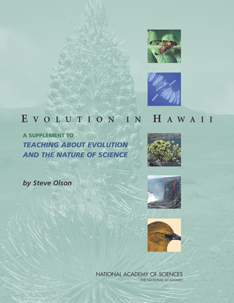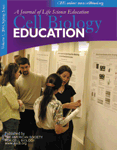From the National Academies
This article provides information about three sets of resources from the National Academies.1 The new Marian Koshland Science Museum of the National Academies is scheduled to open in April 2004. This museum will feature state-of-the-art, interactive exhibits and a Website that are intended for high school students and adults who wish to understand both scientific bases and policy implications of critical issues in modern society. Beyond Discovery: The Path from Research to Human Benefit, is a series of articles published by the National Academy of Sciences that will be of direct interest to scientists in all fields who are working to improve education. A forthcoming book, Evolution in Hawaii: A Supplement to Teaching About Evolution and the Nature of Science, will help students learn about the evidence for evolution that has emerged from extensive research on the picture-winged drosophilid flies and the silversword alliance of plants in the Hawaiian Islands.
1The National Academies is a private, nonprofit organization whose charter is to assist the federal government and the American people in analyzing pressing science and technology policy issues. The National Academies include three honorific societies, the National Academy of Sciences, National Academy of Engineering, and Institute of Medicine. The National Research Council serves as the operating and research arm. Much of the work of the National Academies is performed by leading scientists, mathematicians, engineers, social scientists, and policy experts who provide pro bono service to the National Academies and the nation
MARIAN KOSHLAND SCIENCE MUSEUM
The Marian Koshland Science Museum, a new museum exploring the links between scientific research and everyday life, will open in Washington, DC in April 2004. Operated by the National Academy of Sciences, the museum will explore the science at the core of public policy decisions.
The mission of the Marian Koshland Science Museum is to provide the public with a greater understanding of and appreciation for the value of science by revealing its impact on people's daily lives. Content for the museum is derived from reports produced by the National Academies. These studies will serve as the basis for future exhibits that have the potential to explore all aspects of science, engineering and medicine. Over 20 members of the National Academies and other experts participated in developing the museum's current exhibits, ensuring scientific accuracy and objectivity.
Visitors to the museum will discover the practical applications and social implications of scientific research through engaging exhibits that involve unique interactive displays, graphics, videos, and scientific projections. Two of the museum's three exhibits will be temporary and on view for approximately two years before traveling to other museums across the country.
Wonders of Science, the Koshland's permanent exhibit, will feature animations of groundbreaking research and scientific discovery. Putting DNA to Work will detail several applications of DNA sequencing, from tracking the origin of SARS to the widespread use of DNA in criminal forensics. Global Warming Facts & Our Future will reveal the science behind climate change and examine the possible implications of this phenomenon for the quality of life around the world.
The museum is named after Marian Koshland (1921-1997), a member of the National Academy of Sciences who made major contributions to the field of immunology and molecular biology throughout her career, including work on the cholera vaccine and groundbreaking research in the behavior of antibodies. This new museum has been made possible by a $25 million endowment from her husband, Daniel Koshland, also a member of the National Academy of Sciences and former editor of Science.
The Marian Koshland Science Museum will offer a wide range of educational programs for students and adults, inspired by the museum's exhibits, including hands-on activities, educational field trips, and other special events throughout the year. The museum will occupy approximately 6,000 sq. ft. of street-level space at the corner of 6th & E Streets, NW in Washington, DC, adjacent to the Academies' new Keck Center. For more information, visit online at http://www.koshland-science-museum.org or call 202-334-1201.
BEYOND DISCOVERY: THE PATH FROM RESEARCH TO HUMAN BENEFIT
Beyond Discovery is a series of articles available on the Website of the National Academy of Sciences ( http://www.beyonddiscovery.org/) that traces the origins of important recent technological and medical advances. Each article reveals the crucial role played by basic science, the applications of which could not have been anticipated at the time the original research was conducted. All of these articles should prove useful as supplements for advanced high school, undergraduate, and beginning graduate students. The aerticles can help students understand the importance of basic research in its own right and how fundamental discoveries often have the potential to yield applications that can benefit humankind, even though those benefits may be far in the future and the pathways to those discoveries circuitous (and sometimes tortuous). Together, these articles emphasize that new insights typically build upon a series of seemingly unrelated fields of research, false starts, and new ways of looking at data. They also elucidate the coevolving relationship between progress in research and technological advances.
Each full-color article is between 8 and 14 pages long and can be downloaded without cost as text or as pdf files. All articles contain a glossary of terms and a timeline that enables students to better understand both the amount of time that is sometimes required to move from basic research to technological and other kinds of breakthroughs. Each article also contains Internet links to Websites that can provide additional detail or to sites where students can read more about the careers and perspectives of scientists who were directly involved with the discovery under discussion. A professional science writer wrote each of the articles with the assistance of knowledgeable scientists who may have participated in the work described.
A total of 21 articles is currently available for downloading in Agriculture, Biology, Chemistry, Earth Sciences, Economics, Environmental Sciences, Health, Mathematics, Physics, and Technology. Because of the interdisciplinary nature of these topics, most of these articles are cross-listed r within several of these categories. Within Biology, the following articles are available (year of publication is indicated in parentheses):
Curing Childhood Leukemia (1997)
Designer Seeds (1998)
Disarming a Deadly Virus: Proteases and Their Inhibitors (2000)
From Explosives to the Gas that Heals: Nitric Oxide in Biology and Medicine (2000)
Human Gene Testing (1996)
Insect Pheromones: Mastering Communication to Control Pests (2003)
A Life-Saving Window on the Mind and Body: The Development of Magnetic Resonance Imaging (2001)
Polymers and People (1999)
Preserving the Miracle of Sight: Lasers and Eye Surgery (1998)
Sound from Silence: The Development of Cochlear Implants (1998)
Sounding Out the Ocean's Secrets (1999)
The Hepatitis B Story (2000)
Unraveling the Enigma of Vitamin D (2000)
Many of these articles have been translated into one or more languages, including Chinese, Japanese, French, and German. The Beyond Discovery Website is maintained by the National Academies' Office of News and Public Information. For additional information, call (202) 334-2138 or send e-mail to [email protected].
EVOLUTION IN HAWAII
Evolution in Hawaii: A Supplement to Teaching About Evolution and the Nature of Science is a new book that builds on the 1998 report from the National Academy of Sciences, Teaching About Evolution and the Nature of Science. The report is directed primarily to high school biology teachers to help them present ideas about and evidence for evolution more effectively to their students. It contains specific evidence for evolution from research that has been undertaken on the assemblage of plants called the silversword alliance and the many species of picture-winged drosophilid flies in Hawaii.
An investigative classroom/laboratory exercise prepared by teachers accompanies the report. Using real data based on inversions in polytene chromosomes from 18 species of picture-winged Drosophila that are endemic to Hawaii, students construct evolutionary trees depicting the relationships of the species and investigate the link between speciation and the ages of the Hawaiian islands. By letting students explore the mechanisms involved in the origin of species, the teaching exercise demonstrates how descent from a common ancestor can produce organisms with widely varying characteristics. This exercise also could be used in undergraduate introductory courses in general biology or evolution.
This publication has been designed specifically to supplement a broader consideration of evolution. By exploring a particular example in depth, it illuminates the general principles of evolutionary biology and demonstrates how ongoing research is continuing to expand our knowledge of the natural world. A related book, Science and Creationism: A View from the National Academy of Sciences, 2nd edition (NAS, 1999), considers at greater length the arguments used by those who oppose the teaching of evolution in public school.
The report was authored by Steve Olson2 with input and assistance from Hampton Carson, Elysse Craddock, and Kenneth Kaneshiro. It was reviewed by prominent evolutionary biologists and high school teachers.
2Steve Olson has worked for the National Academy of Sciences, the White House Office of Science and Technology, and the Institute for Genomic Research. A science journalist with more than twenty years of experience, he is the author of several books, including Shaping the Future and Biotechnology, Mapping Human History: Discovering Our Past Through Our Genes, Mapping Human History: Genes, Race, and Our Common Origins, and Mapping Human History: Unravelling the Mystery of Adam and Eve. He has written for Atlantic Monthly, Science, and other magazines.
At the time that this article was prepared, plans were underway to distribute most copies of this report and the teaching units electronically (on CD or directly downloadable from the National Academies Press Website). The electronic bundle also will contain the original reports from the National Academy of Sciences on Teaching About Evolution and the Nature of Science (NAS, 1998) and Science and Creationism, 2nd ed. (NAS, 1999). For additional information, contact Jay Labov (202-334-1458; [email protected]).

ACKNOWLEDGMENTS
I thank Bruce Alberts, Jennifer Saxon, and Steve Olson for contributing text and reviewing an early draft of this manuscript.



